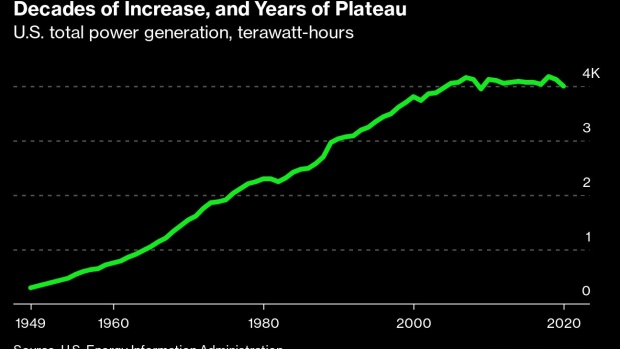Mar 31, 2022
Yesterday’s Energy Solutions Are Tomorrow’s Energy Problems
, Bloomberg News

(Bloomberg) --
In 1950, the entire U.S. power generation sector generated a bit more than 300 terawatt-hours of electricity. Today, the sector generates more than 4,000 terawatt hours, and wind energy alone generated more in 2020 than the entire sector in 1950.
The story of electricity in the U.S. is not simply a story of exceptional growth, however. It is also a story of a significant plateau. U.S. power generation has been more or less flat since the end of the first decade of this century. That’s testament to greater efficiency and to slower economic growth after the global financial crisis.
Underneath that electricity plateau though are a number of other major energy stories of growth and expansion, peaks and valleys, second winds and near-deaths. All are relevant for today and for the future.
Coal, for instance, is a clear peak. It was the single biggest source of power through the late 2000s, with a significant decline since then. Nuclear is a clear plateau, up from nothing in the 1950s to a steady state since the turn of the century. Hydro is seasonal, with peaks and valleys depending on resource. Natural gas, which peaked in the early 1970s, subsided for years, and then soared again in the 1990s through to today.
Oil-fired power and renewables (wind, solar, geothermal, biomass, and waste) are what really interest me. Oil-fired power generation soared from the 1960s right through to the second oil shock of the late 1970s, and was in fact the nation’s third-biggest source of power in 1973, behind coal and natural gas. Its rate of growth was rapid, and its timing, so to speak, spectacularly poor as it aligned with not one but two oil shocks.
Renewables present two curves, really — a late-1980s surge driven by friendly policies and a big build-out of renewable generation in California in particular, and then a rapid and smooth rise from the mid-2000s to today. Renewables now generate more power than oil ever did, and more than large hydro does as well.
Resource availability and the economics of power generation from each source are obviously major determinants of each of these curves. But it is essential to remember as well that these curves are the results of policies and regulations or, to put it more plainly, choices.
Professor Michael Webber of the University of Texas recently provided me with a capsule history of some of those choices. That oil-fired power generation, arriving just in time for the oil shocks, meant that the public “freaked out.” As he says, “It’s one thing to lose your ability to drive to work, that’s annoying. But to lose electricity is a much bigger risk because the world’s food preservation and water treatment systems run on electricity. So a gasoline outage is disruptive but a power outage is life-and-death.”
The response to that freak out? The U.S. accelerated its construction of coal and nuclear capacity, as seen in the charts above. At the same time, three other trends were underway with significant implications for U.S. power generation. First, air quality regulations were clamping down on higher-sulfur coal in the U.S. east and oil-fired power everywhere. Second, railroad deregulation made it much cheaper to bring low-sulfur coal from Wyoming, in particular, to points east. Finally, in 1978 the U.S. prohibited construction of new gas-fired plants — based on an assumption that the U.S. was running out of gas and would need what remained for industrial use.
The result, in particular for the wave of coal-fired power plants built in the 1970s and 1980s, is a bit ironic. As Webber says, “We yell at utilities today to shut down coal plants for security and environmental reasons but in the 1970s and 1980s, we were yelling at utilities, begging them to build those exact same coal plants for security and environmental reasons.”
Yesterday’s solutions, in other words, are tomorrow’s problems. It is therefore worth considering what today’s dominant trend — a massive build-out of wind and solar generation — will require of future planners and investors.
Complementing their low cost, variability and seasonality will certainly require massive amounts of energy storage capacity. But it could require more — potentially hydrogen or bio-methane used in conventional gas turbines, or even small nuclear reactors to quickly provide zero-carbon power. Long-term stability, coupled with deep de-carbonization, will mean building a great deal. It will also mean anticipating new challenges before they become systemic problems.
Nathaniel Bullard is BloombergNEF's Chief Content Officer.
©2022 Bloomberg L.P.


